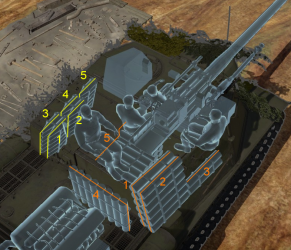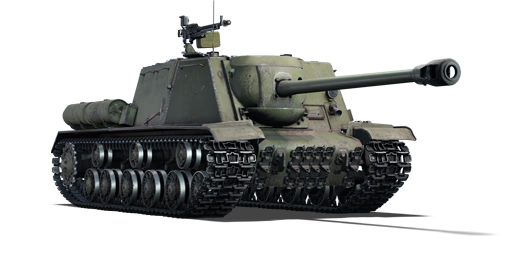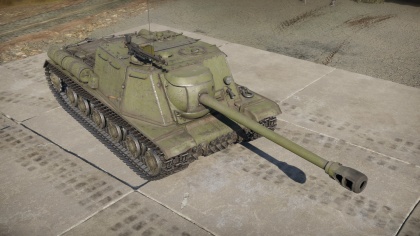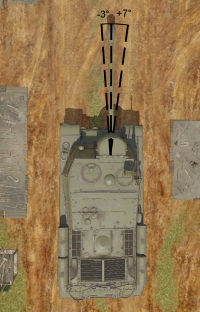Difference between revisions of "ISU-122S"
(→Main armament: Added precisions on the handling of the gun + ammunition description) |
(→Survivability and armour: Added precisions) |
||
| Line 19: | Line 19: | ||
'''Armour type:''' | '''Armour type:''' | ||
| − | * Rolled homogeneous armour | + | * Rolled homogeneous armour (hull, superstructure/casemate, roof) |
* Cast homogeneous armour (Gun mantlet) | * Cast homogeneous armour (Gun mantlet) | ||
Revision as of 16:32, 15 June 2020
Contents
| This page is about the tank destroyer ISU-122S. For the version equipped with an A-19 cannon, see ISU-122. |
Description
The ISU-122S is a rank Russian tank destroyer
with a battle rating of (AB), (RB), and (SB). It was introduced during the Closed Beta Test for Ground Forces before Update 1.41. Compared to the ISU-122, the ISU-122S presents a better 122 mm cannon by allowing for faster reloads.
General info
Survivability and armour
Armour type:
- Rolled homogeneous armour (hull, superstructure/casemate, roof)
- Cast homogeneous armour (Gun mantlet)
| Armour | Front | Sides | Rear | Roof |
|---|---|---|---|---|
| Hull | 60 mm (75°) Front glacis 90 mm (31°) Lower glacis |
90 mm | 60 mm (50°) Top 60 mm (39°) Bottom |
30 mm |
| Superstructure | 90 mm (30°) Front glacis 100 + 65 mm (7-35°) Gun mantlet |
75 mm (14-15°) | 60 mm | 30 mm |
Notes:
- Suspension wheels are 20 mm thick while tracks are 30 mm thick.
- There is a plate of 40 mm thick under the gun mantlet, reinforcing the original 65 mm gun mantlet case.
Mobility
| Game Mode | Max Speed (km/h) | Weight (tons) | Engine power (horsepower) | Power-to-weight ratio (hp/ton) | |||
|---|---|---|---|---|---|---|---|
| Forward | Reverse | Stock | Upgraded | Stock | Upgraded | ||
| Arcade | Expression error: Unexpected * operator. | 739 | Expression error: Unexpected round operator. | __.__ | |||
| Realistic | 460 | Expression error: Unexpected round operator. | __.__ | ||||
Based off the IS-2, the ISU-122S has its robust chassis, wide tracks and powerful engine. It benefits thus from the same good mobility all while being a heavy vehicle. The acceleration is good and reaching the maximum speed takes only a dozen seconds.
The very high reverse speed is a positive aspect, that will help you get out of enemy sight quickly once you've fired or once spotted. The wide tracks give it a good handling and performance on soft terrain.
A negative aspect of the ISU-122S is that it is sluggish in stock condition, especially when turning on the spot. And because of its weight, it is slow when going uphill.
Armaments
Main armament
| 122 mm D-25S | Turret rotation speed (°/s) | Reloading rate (seconds) | |||||||||||
|---|---|---|---|---|---|---|---|---|---|---|---|---|---|
| Mode | Capacity | Vertical | Horizontal | Stabilizer | Stock | Upgraded | Full | Expert | Aced | Stock | Full | Expert | Aced |
| Arcade | 30 | -3°/+22° | -3°/+7° | N/A | 6.16 | 8.53 | __.__ | __.__ | 12.19 | 19.76 | __.__ | __.__ | 15.2 |
| Realistic | 4.17 | 4.9 | __.__ | __.__ | 7.0 | ||||||||
The 122mm D-25S comes from the same design as the 122m D-25T equipped on the IS-2. They have the same ballistic characteristics, the same reload time and the same available ammunition choice. The S stand for "samokhodnaya" (self-propelled) while the T stand for tank, the main difference being the length of the breech: short breech for the IS-2 in its cramped turret and long breech for the ISU-122S because of the casemate layout.
The gun stays reliably accurate until 1,300 m distance. Beyond 1,000 m your optics will limit your accuracy as your magnification is poor (unless you fire at huge targets like Ferdinand, Jadgtiger, Tiger II, etc.). The high muzzle velocity of your shells grants you pretty flat firing trajectories and thus helps fire at moving targets from a distance. In that regard, using the "sight control distance" feature can increase your chances of successfully hitting enemy tanks.
The gun has a limited traverse on the horizontal axis. That displacement is asymmetrical due to the commander's position limiting rotation towards the left side. This can make the tracking of a target difficult as the gun quickly reaches a stop. You should take that constraint into account when positioning your hull at a firing spot.
Additionally, the rotation speed is very slow compared to other tanks at the same rank or battle rating who can aim their gun in average 2 times faster than you do. Which means your targeting process will be longer than for other tanks if you aim to be accurate. Any enemy appearing outside of the area your gun covers will require hull movement and will make you restart your targeting process from 0.
Being originally an artillery field gun, the gun uses two-piece ammunition with projectiles and propellant bags. This causes the reload time to be 2 to 3 times longer compared to vehicles at the same BR.
Your recoil is important but not powerful enough to throw your gun off target after firing: the damping cylinders on the gun are too weak to absorb most of the recoil power and the suspension will absorb much of it. Your reload time being very long, the recoil is not as much of a handicap as it could be.
Ammunition
The available choice of ammunition focuses on heavily armoured targets:
- BR-471: APHE; an armour-piercing shell with high explosive mass and high muzzle velocity that will one-shot any tank that it penetrates.
- BR-471B: APHEBC; the same as the BR-471 but with increased penetration thanks to the ballistic cap. This shell can reliably penetrate the frontal glacis of a Panther from over 700m.
- OF-471: HE; for destroying open and lightly armoured vehicles. While it is a standard shell for a Soviet vehicle, prioritize using your heavy machine gun to deal with lightly armoured targets because of the long reload time of the ISU-122S.
| Penetration statistics | |||||||
|---|---|---|---|---|---|---|---|
| Ammunition | Type of warhead |
Penetration in mm @ 90° | |||||
| 10m | 100m | 500m | 1000m | 1500m | 2000m | ||
| BR-471 | APHE | 205 | 201 | 183 | 162 | 144 | 128 |
| BR-471B | APHEBC | 205 | 203 | 191 | 178 | 166 | 155 |
| OF-471 | HE | 37 | 37 | 37 | 37 | 37 | 37 |
| Shell details | ||||||||||
|---|---|---|---|---|---|---|---|---|---|---|
| Ammunition | Type of warhead |
Velocity in m/s |
Projectile Mass in kg |
Fuse delay
in m: |
Fuse sensitivity
in mm: |
Explosive Mass in g (TNT equivalent): |
Ricochet: | |||
| 0% | 50% | 100% | ||||||||
| BR-471 | APHE | 795 | 25 | 1.2 | 19 | 246.4 | 47° | 60° | 65° | |
| BR-471B | APHEBC | 795 | 25 | 1.2 | 19 | 246.4 | 48° | 63° | 71° | |
| OF-471 | HE | 800 | 25 | 0.1 | 0.1 | 3,600 | 79° | 80° | 81° | |
Ammo racks

| Full ammo |
Ammo type |
1st rack empty |
2nd rack empty |
3rd rack empty |
4th rack empty |
5th rack empty |
Visual discrepancy |
|---|---|---|---|---|---|---|---|
| 30 | Projectiles Propellants |
25 (+5) 25 (+5) |
19 (+11) 19 (+11) |
13 (+17) 17 (+13) |
7 (+23) 9 (+21) |
1 (+29) 1 (+29) |
No |
Notes:
- The ISU-122S uses two-piece ammunition, composed of propellant bags (orange) and projectiles (yellow). Both have separate racks.
- To go into battle with the right flank depleted of propellant bags (racks 1 to 3), pack 17 (+13) shells.
Machine guns
The 12.7 mm DShK heavy machine gun is located on a pintle mount and can act as both an offensive and anti-aircraft machine gun on the ISU-122S, giving it protection against aircraft and lightly armoured vehicles. Best use is within 500 m against lightly armoured vehicles. The 360° movement allows you to point quickly your MG in any given direction. However, the position of the MG high on the casemate and the poor depression angle make it difficult to shoot a low-profile tank when it is close.
| 12.7 mm DShK | ||||
|---|---|---|---|---|
| Mount | Capacity (Belt) | Fire rate | Vertical | Horizontal |
| Pintle | 250 (50) | 600 | -5°/+85° | ±180° |
Usage in battles
Describe the tactics of playing in the vehicle, the features of using vehicles in the team and advice on tactics. Refrain from creating a "guide" - do not impose a single point of view but instead give the reader food for thought. Describe the most dangerous enemies and give recommendations on fighting them. If necessary, note the specifics of the game in different modes (AB, RB, SB).
Modules
| Tier | Mobility | Protection | Firepower | ||
|---|---|---|---|---|---|
| I | Tracks | Parts | Horizontal Drive | ||
| II | Suspension | Brake System | FPE | Adjustment of Fire | BR-471B |
| III | Filters | Crew Replenishment | Elevation Mechanism | ||
| IV | Transmission | Engine | |||
Pros and cons
Pros:
- Deadly cannon provides superior one-shot capacity with any target upon penetration. The improved firerate increases its killing potential even more.
- Powerful stock AP penetrates up to 205mm which is very effective in a full uptier. For example the weakspots of the early Centurions, Ferdinand, Tiger II H can all get penetrated with ease.
- The huge gun mantlet and its complex armor is capable of deflecting quite some shells sometimes.
- 30mm roof armor resists popular aircraft weapons well, like the 12.7mm M2 with ground target belt and the MG 151.
- All-round protection provides good resistance against flanking SPAAs. The M19 / M42 are very common flankers.
- 14 km/h reverse speed allows it to retreat from danger quickly
Cons:
- Reload time of 19s is still quite long, demanding precise aiming which isn't very beginner friendly.
- Front armour is only 60-100mm and is not well angled. Gets penetrated easily by common guns at the BR, like the 76mm M1, 17 pdr, 75mm and 88mm.
- Closely packed crew all easily get killed when an explosive shell penetrates.
- Very inadequate gun depression of -3° combined with the sluggish mobility makes it only capable of fighting in urban (flat) areas, but never the hills.
- Turretless layout and the sluggish mobility makes it very vulnerable to surprise flankers, for example the infamous M18, T20, T25 and Puma.
- Gun breech often gets damaged while under enemy fire.
History
Development
When the ISU-152 began production in 1943 with the large 152 mm ML-20S gun, production of the chassis and hull soon exceeded the supply of the ML-20S gun, which caused a decrease in the production of self-propelled guns for the Soviet military. It was determined to speed up self-propelled gun production, the ISU chassis were to be mounted with the 122 mm A-19S gun. Work on this mounting already began before the supply issue in December 1943 at the Chelyabinsk Kirov Plant (ChKZ), which had a design team simply take the ISU-152 chassis and hull and only changing out the armament with the 122 mm gun, but this prototype - Object 242 - was not immediately put into production despite successful testings. When the supply issue arose, the prototype was then adopted by the Soviet Defense Committee for increased production and also that the 122 mm gun had better accuracy against tanks than the 152 mm gun. The ISU armed with the 122 mm gun, designated the ISU-122, began production in April 1944.
Upgrade
The original ISU-122 is equipped with the 122 mm A-19S gun, which had a firing rate of 1.5 to 2.5 shots per minute due to its manual-piston breech. An attempt to fix this was a modernized A-19 gun called the D-25. The D-25 didn't see instalment onto the ISU-122 for a while due to prioritization on the IS-2 tanks, but it was available for use on self-propelled mounts after September 1944 as the D-25S. The ISU-122 prototype mounting the D-25 gun was called Object 249 which was successfully tested and an improvement over the A-19 gun with an increased firing rate of 2 to 3 shots per minute with one loader and up to 4 shots per minute with an additional loader in the crew. The D-25 also exploited the use of a muzzle brake in order to reduce the recoil forces on the gun, so the recoil buffer on the D-25 was much smaller than the A-19, which helped reduce the size of the gun and improved crew workspace in the self-propelled gun. Object 249 was then adopted as the ISU-122S, which entered production side by side with the ISU-122 u and both were produced up until the end of 1945. ChKZ produced both vehicles during the war and manufactured 1,735 ISU-122s (April 1944 - December 1945) and 675 ISU-122Ss (September 1944 - December 1945).
Combat usage
The ISU-122 were organized in units in a similar fashion as the ISU-152. The focus was made to not mix the two vehicles in the same regiments or brigades due to logistical reasons with ammunition and ballistic differences in indirect fire, but some units were equipped with both vehicles anyways. Like the ISU-152, the ISU-122 proved to be a very powerful multi-purpose vehicle as an assault gun, self-propelled artillery, and tank destroyer. The 122 mm gun on the ISU-122 allowed it to engage armour and fortifications with heavy armour-piercing round and a large high-explosive round. The primary role of the ISU-122 was as a tank destroyer due to the gun's superior ballistics compared to the ISU-152's, which large calibre size more suited its role as an assault gun. The ISU-122 did participate as an assault gun role in urban combat to support the infantry, but the lack of rotating turret and long barrel length restricted its manoeuvring and ability to engage all enemies in a large angle. Nevertheless, commanders found the ISU-122 as a very good assault gun. Usage of the ISU-122 in an indirect firing role as a howitzer is rare, but when used could fire up to 14 kilometres away. Usage as an artillery piece is more likely during a rapid offensive where towed artillery behind the lines is unable to keep up with the advancing infantry lines.
In-game description
The ISU-122S self-propelled gun was created in April 1944 as a modernised variation of the ISU-122 SPG. It differed from the latter in that it was equipped with a 122 mm D-25S Mod. 1944 cannon with a wedge-type semi-automatic breech block and a muzzle brake. The barrel's length came to 48 calibres. The height of its firing line came to 1,795 mm. The vehicle had a five-man crew and its crew housing was the same as in the ISU-122. The use of this cannon increased its rate of fire in combat from 2.2 to 3 shots per minute. The cannon's new compact recoil mechanisms and breech housing provided better working conditions for the combat crew. Artillery superiority over the enemy had been absent for some time, but the use of the D-25S cannon brought it back. It had higher combat characteristics than the German 75 mm and 88 mm weapons, and penetrated enemy tank armour at a range of up to 2,500 m. In urban battles however, the 122 mm cannon's barrel length often prevented the vehicle from manoeuvring in tight spots.
From August 1944 to September 1945, the ISU-122 with its A-19 cannon and the modernised ISU-122S with its D-25S cannon were produced in tandem, as the 122 mm D-25S cannon supply was insufficient to furnish all the SPGs. By the 1st of June 1945, 475 ISU-122S SPGs were built and used in battles in the final stage of the Great Patriotic War. In total, 675 of them were made in their mass production period.
ISU-122S SPGs were used across the entire functional scope of self-propelled artillery application. It was used as an assault weapon in breaking through fortified zones and in urban battles, but with reduced effectiveness in comparison to the ISU-152. On the whole, the SPG was highly regarded in this role as well. In the middle of the 1960s, the SPGs were removed from service in the Soviet Army.
Media
Skin and Camouflages for the ISU-122S in Warthunder Live.
See also
Links to the articles on the War Thunder Wiki that you think will be useful for the reader, for example:
- reference to the series of the vehicles;
- links to approximate analogues of other nations and research trees.
External links
| USSR tank destroyers | |
|---|---|
| SU-76M | SU-76M · SU-76M (5th Gv.Kav.Corps) · SU-85A |
| SU-57B | SU-57B · SU-76D |
| T-34 Derivatives | SU-122 · SU-85 · SU-85M · SU-100 · SU-122P |
| Heavy Tank Derivatives | SU-100Y · ISU-122 · ISU-122S · SU-152 · ISU-152 · Object 268 |
| SU-100P and Derivatives | SU-100P · Object 120 |
| Wheeled | YaG-10 (29-K) |
| Airborne | ASU-57 · ASU-85 |
| Rocket | BM-8-24 · BM-13N · BM-31-12 |
| ATGM | IT-1 · Shturm-S · Object 775 · Khrizantema-S |
| Artillery | 2S1 · 2S3M |
| Other | SU-5-1 · ZiS-30 · SU-122-54 |
| USA | SU-57 |






